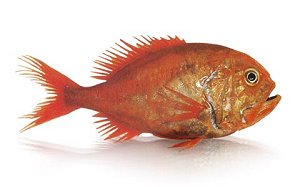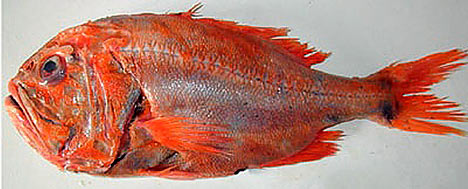
Hoplostethus atlanticus
FAMILY
Trachichthyidae
TAXONOMY
Hoplostethus atlanticus Collett, 1889, Florйs, Azores, sta. 203,
1557 m.
OTHER COMMON NAMES
English: Deep sea perch, red roughy, slimehead; French: Hoplostиte
orange; German: Degenfisch, Granatbarsch, Kaiserbarsch;
Spanish: Raloj anaranjado
PHYSICAL CHARACTERISTICS
Among the largest of the beryciform fishes, and possibly the
largest, with some specimens up to 29.5 in (75 cm) in length.
Has vivid orange-red coloration and a slightly jutting lower
jaw.
DISTRIBUTION
Disjunct populations in tropical, subtropical, and temperate
waters worldwide.
HABITAT
Prefers deep waters 590–5,900 ft (180–1,800 m) deep over
steep or rough structures, particularly seamounts.
BEHAVIOR
Apparently sedentary rather than migratory. Remains in deep
waters most of its life. Little is known about the young, but
they are believed to primarily inhabit deep waters, too.
FEEDING ECOLOGY AND DIET
Diet is made up of small fishes, shrimps, squids, and other invertebrates.
Predators include other fishes of their
HABITAT
, such
as basketwork eels (Diastobranchus spp.).
REPRODUCTIVE BIOLOGY
Large groups of orange roughies congregate in annual mating
schools. The schools may last one to two weeks, during which
mature adults (30 years old and more) spawn and then leave
the area. Females produce 10,000–90,000 eggs, which are fairly
large at 0.08 in (2 mm) and spherical. The eggs drift toward
the surface, where they hatch about two weeks later.
CONSERVATION STATUS
Although the orange roughy is not listed by the IUCN,
catches have been restricted to help ensure a continued commercial
harvest.
SIGNIFICANCE TO HUMANS
Best known as a commercial food fish, providing millions
of pounds of harvest each year. Commercial harvests are
now restricted, but past annual harvests have topped 100 million
pounds (45 million kg) in the waters off Australia and
New Zealand.
Photo Gallery of - Orange roughy





 Animalia Life
Animalia Life